
Fabrics and know-how
A fabric creator since 1935, Maison Pierre Frey knows how to combine the know-how of exceptional craft techniques with new and innovative processes.

Our expertise
A recognized editor, Pierre Frey has also been a manufacturer since the nineteen-eighties. Located in northern France, the factory was awarded the prestigious "EPV" (Entreprise du Patrimoine Vivant or Living Heritage Company) label. Awarded by the Ministry of the Economy and Industry, it recognizes French companies with artisanal and industrial excellence. Pierre Frey is especially known for its expertise in the weaving of wools and high-performance outdoor textiles.

FABRICS
JACQUARD WEAVING
Invented in 1801, the jacquard loom made it possible to create fabrics with complex patterns, such as brocade or damask. Each warp thread is controlled individually, which enables an infinite number of options for interweaving and binding with the weft threads.

HAND WEAVING
Hand weaving is a traditional technique. Today, this precious know-how is very rare and requires the expertise of exceptional craftsmen. This manual process requires patience and the precision of a skilled and knowledgeable technique. Beyond the fabric itself, we can sense the intimate relationship that ties the artisan to his work and makes it unique.

TOILES DE TOURS
Designed in the twenties by Georges Le Manach, toiles de Tours correspond to a type of weaving implemented on specific looms that allow the rapid and made-to-measure execution of a broad variety of customizable jacquard designs in limited fabric lengths (three meters minimum).

WARP PRINTING
This ancient process is designed to print a motif on the surface of the warp threads before the fabric is woven. Since it is a flatbed print on the warp threads, the motif appears slightly striated and blended. This minute and demanding technique involves several steps requiring much patience and the mastery of rare know-how.

SCREEN PRINTING
Screen printing is a technique that consists in building a motif on the surface of a fabric by means of the successive application of stenciled frames. Color after color, expert artisans carefully create the motif zone by zone through the mesh of the printing frame.

DIGITAL PRINTING
The digital printing of textiles is a contemporary process that allows obtaining an unlimited number of colors in a design. Perfect for shaded motifs or to reproduce the richness of a large number of chromatic tones, this technique uses a screening system based on a digital image.

WOODBLOCK PRINTING
In this very ancient process, raised motifs are engraved on wooden blocks to which color is applied. These wooden blocks are then placed on the fabric by hand according to markings. On average, a craftsman produces twenty-five meters of four-color printed fabric in one day.

EMBROIDERY
Embroidery is an ancestral technique for decorating textiles. It consists of adding a flat or raised design to a fabric using threads, beads or other materials that can be sewn to the cloth. Hand- or machine-made, this process adds refinement, contrasting materials and volume to the textile surface.

VELVET
A soft, lustrous material, velvet is the result of a special weaving technique that involves a double warp. Woven on a hand or electronic loom, the fabric is made by inserting metal rods called “velvet irons” into the weave; rod thickness determines the size of the loop. Velvet’s matte or shiny aspect depends on the material used for weaving (wool, cotton, silk, etc.).

WALLPAPERS
SCREEN PRINTING BY HAND
In use since 1970, this traditional process replaces the ancient woodcut. It requires unique know-how that involves patience and precision along with expertise. Each design is separated into a number of colors. Several color trials are made to obtain the perfect shade. Craftsmen manually position the stencil frames, one after the other, and then scrape the color by hand across the inside of the frame.

TRADITIONAL ROLLER PRINTING
This technique, based on direct printing on the material, admirably reproduces a hand-printed effect. Color is deposited in the small cavities of a flexible roller that has been engraved. The print is obtained by pressing the roller onto the material to be printed. Technological innovation now allows printing up to 12 colors by subtly combining a hand-painted effect with a meticulous reproduction of details and a 3D rendering.

ENGRAVED PRINTING
This modern technique is often used to bring out textural effects. It results in a very precise print and enables playing with color shades, metallic inks and UV varnishes. In particular, it is used for registered printing.

BEADED OR FLOCKED EFFECT
Rather complex, this technique results in a paper that is textured with microbeads and has a shiny, sophisticated finish. A type of adhesive is printed on a non-woven material and small acrylic beads are applied to this coating using an electrostatic method.

EMBOSSING
Embossing is used to obtain raised-design wallpaper. At Pierre Frey, hot embossing is the process used. On a vinyl base, the design colors are first printed with flat rollers. Next, the engraved cylinder is heated to create the imprint of a textured effect by high-temperature embossing. The aspect of the paper is refined with an overprint of paint on the highest parts of the raised motif.

DIGITAL PRINTING
Along with traditional techniques, Pierre Frey uses cutting-edge technology to enhance creation and has chosen a digital solution for producing certain designs. Particularly appropriate for figurative designs, digital printing offers a highly appreciated hyperrealistic rendering of trompe l’oeil effects. It transcribes the meticulous designs of several company artists in an exceptional way.

RUGS & CARPETS
THE AUBUSSON-TYPE FLAT-WEAVE
The hand-woven Aubusson type is entirely handmade and was historically used at the Aubusson Manufactory. Each piece is wove, like a cloth, on horizontal looms. Originally used for wall tapestries in castles, it was adapted in the 18th century for a use on the floor with thicker contextures. Woven backwards, this stitch is usually intended for old drawings from Pierre Frey archives.

HAND-KNOT OR SAVONNERIE KNOTS
Manufactured on vertical looms, the hand-knot Savonnerie type is a craft process that requires extreme meticulousness. This traditional stitch was once used by La Manufacture de la Savonnerie de Paris, from which it takes its name, for the royal residences of the Kings of France.
Made of thick cut pile, this stitch is usually intended for antique designs from Pierre Frey archives.
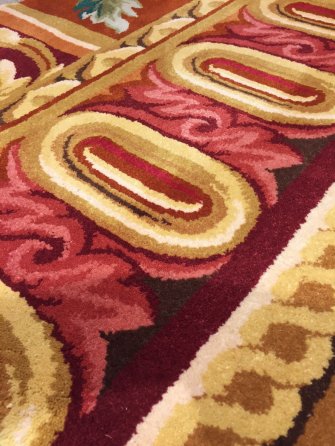
NEPALESE HAND-KNOT
Manufactured on vertical looms, the Nepalese hand-knot is still made today in the Kathmandu valley. The ancestral know-how of this stitch and the fineness of its knots allow renderings of an unparalleled delicacy. The precision of the patterns and the subtly striated effect of its velvet are characteristic of this technique.

FLAT-WOVEN RUGS
Traditional woven rugs are made by hand on looms. These looms offer 2 types of weave structure: flat-woven rugs, which use the side of the yarn for a very soft result, or woven rugs with pile (cut pile or cut/loop pile) which give a thicker and textured result. Whichever is the chosen weaving, this quality is limited to plain, semi-plain and textural effects.

MIXED TECHNIQUE
Pierre Frey’s mixed technique is a quality that blends a flat woven that forms the background of the rug, enhanced by large hand-knots that draw the pattern in relief. Traditionally hand-woven and hand-knotted, this technique is intended for simple geometric patterns with a very characteristic textural effect.
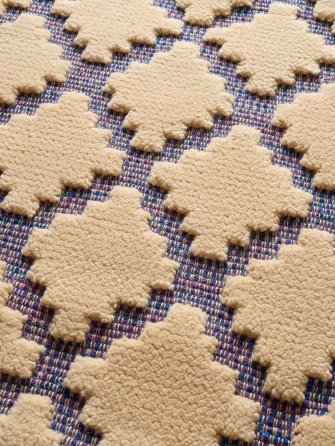
HAND-TUFT
The hand-tuft technique is a process invented in the 1950s. The drawing is transferred to a canvas, stretched on a vertical frame. It is executed by hand using an electric gun to form the velvet. The gun projects the wool strands onto the canvas, stitch by stitch. The skill of this work allows almost any type of design. The density can be adapted according to the projects, as well as the material: wool, silk, synthetic fibers... This is the technique which allows the greatest possibilities of texture effects and different finishings.
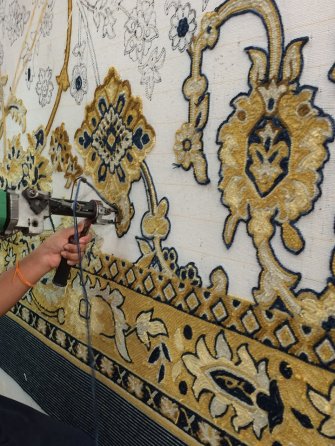
PASS-TUFT
Pass-tuft takes over the principle of hand-tuft in a more mechanical process. The hand-gun is replaced by a small machine that will apply the wool strands from a complete area at the same time. This technique is only used to produce plain, semi-plain, stripes or checks. Widely used in the Natecru collection, this process nevertheless allows to play with texture effects and offers an infinity of materials (wool, silk...).
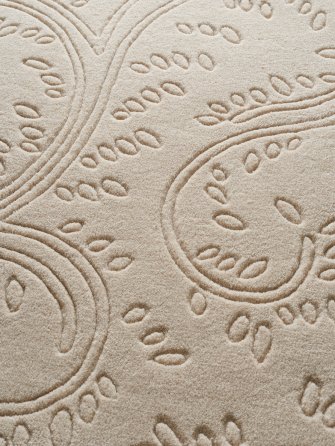
WILTON CARPETS
Wilton weaving is the traditional carpet weaving process. It is a mechanical weaving, made on jacquard looms. The use of semi-worsted wools gives an unequalled fineness and a luminous shine to the velvet. Made on historical looms dating from the 19th century, the carpet can only be woven in strips with a defined width (usually 2.3 feet), which will then have to be assembled manually by sewing or heat welding during installation.

AXMINSTER CARPETS
Axminster weaving was developed in England during the industrial revolution. It is a weaving technique on mechanical looms. It is intended for the production of large quantities, in large widths. The patterns and materials are suitable for intensive use in hotels, restaurants, retail stores or corporate headquarters. The designs are generally composed of repetitive patterns in a limited number of colors, but it is possible to produce large patterns with up to 12 colors.
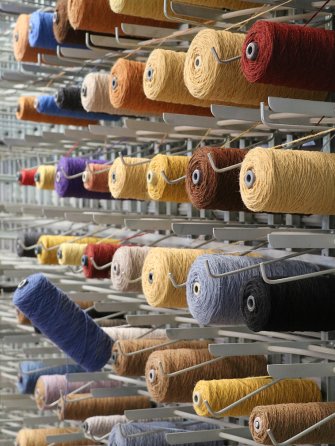
PRINTED CARPETS
Digital printing is a contemporary process that complements traditional techniques. It allows to free ourselves from the limitations of the number of colors imposed by dyeing and the level of detail required by traditional weaving. Freed from all technical restrictions, the studio's creativity is fully expressed in powerful designs, with unparalleled renderings.
True to Pierre Frey's standards, the printed carpets collection is developed with a European workshop that ensures the best possible printing quality. This process offers three types of 100% polyamide quality: a cut pile, a loop pile and a shiny cut pile.
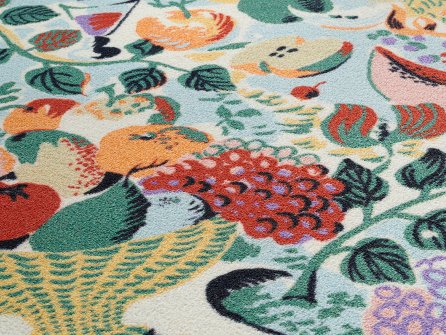
FURNITURE
SELECTED AND CERTIFIED WOOD
The items proposed in the Pierre Frey collection are made in beech. However, the company also offers a variety of wood types for made-to-measure projects. Not all of these woods will be as sturdy and noble, and not all will enable obtaining the same shades and textures. Connoisseurs, cabinetmakers and project managers are welcome to make proposals for projects.

CARPENTRY
Our carpenters select the wood and cut it after having outlined the shape of parts on the wood blocks. With mastery and precision, they follow the curves and design of the item with great delicacy.

TRADITIONAL JOINING
Maison Pierre Frey prefers wood joined according to traditional and very “French” techniques, including mortise and tenon, dowels, dovetails, bridle joints, grooves and tongues. Parts are prepared beforehand to allow joining by width, length or at an angle.

SHADES, VARNISHES AND DECORATIVE TECHNIQUES
The Pierre Frey workshop uses mainly beechwood for its collection. However, it also proposes several other woods and offers a broad palette of finishings and decorative techniques, such as stains, lacquers, patinas, sandblasting, waxes and various types of oiled varnishes and finishings.

SUSPENSION TECHNIQUES
The specifically-designed seat suspension system provides suppleness and firmness. Traditional springs attached by hand are the most comfortable option. Pierre Frey also proposes many other options, according to the way in which the furniture will be used (elastic straps, zigzag or bagged springs, etc.).

PADDING AND COMFORT
Furniture padding and cushions provide softness and well-being. Depending on the required criteria, we propose goose feathers, down, wadding or high-density foam.

TEXTILE EXPERTISE
With several thousand chair fabric possibilities and the existence of five brands with five complementary styles, Maison Pierre Frey offers an incomparable selection to upholsterers and decorators. Based on its expertise, it makes the best recommendation to upholster furniture in accordance with its intended use (abrasion, resistance to light, stains, flame retardant, etc.).

CAREFUL UPHOLSTERING TO ENHANCE SHAPES
The tailors and upholsterers from the Pierre Frey workshop enhance shapes and textile creations with traditional and original finishings, such as welting, trimmings, braiding or studs on fabric that can be stretched, gathered or quilted.

KNOW-HOW
Discover all the know-how that The Maison Pierre Frey is committed to promoting through all its creations.
Discover
Founded in 1935, Pierre Frey is an eclectic French company that creates, edits and manufactures fabrics, wallpapers, custom-made rugs and exceptional furniture.
- Career
- Contact
- Glossary
- Legal Notice
- General data protection policy
- General conditions of sale
- Press area
© Pierre Frey - 2025
